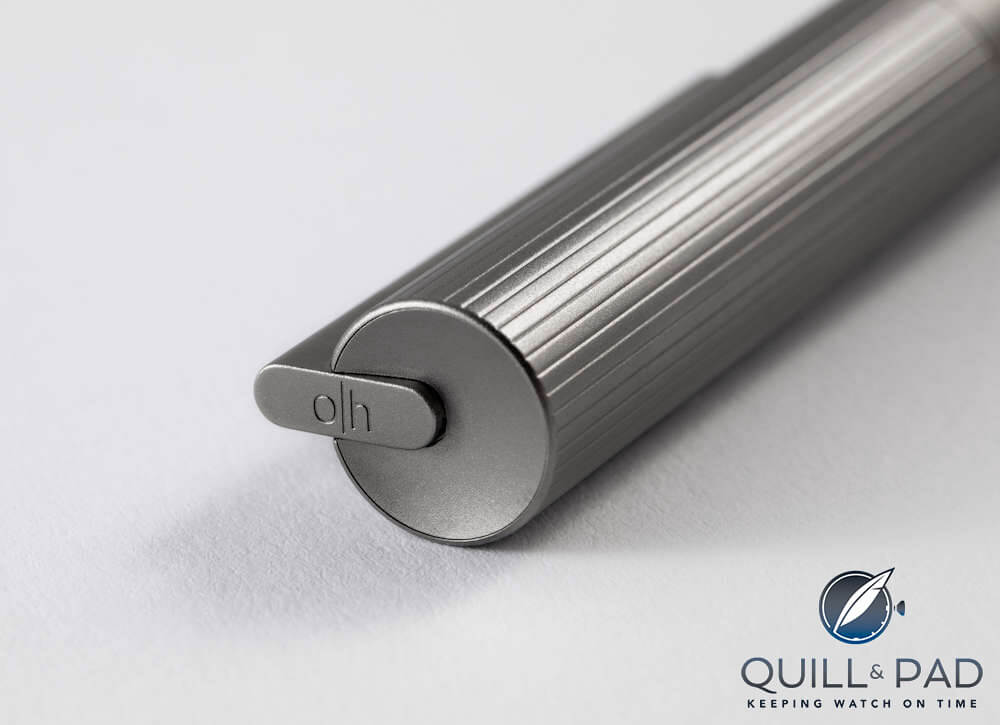by Nancy Olson
When contemplating German pen making, if your mind immediately turns to such brands as Pelikan, Lamy, Montblanc, Faber-Castell, and other storied companies, it’s time to add Otto Hutt to the list. Founded in 1920 in the German jewelry-making epicenter Pforzheim, it produced – and continues to produce – Bauhaus-inspired pens and other small accessories.

Otto Hutt design c
Much has transpired over the last hundred-plus years. In the 1960s, founder Karl Hutt’s son Otto took on the leadership of the company. Still later, Robert E. Huber GmbH reanimated the brand. And although the company has since moved from its first location into a larger facility, still in Pforzheim (but now with over 70 employees), many of the artisanal skills employed in those early years are still used in some fashion today.
“One of the most traditional jewelry-making techniques is guilloche,” says managing director and owner Marco Frei, who, along with Nicole Klingel, revised Otto Hutt’s product range and manufacturing processes. Otto Hutt both continues to carry out this time-tested signature art form by hand and uses modern CNC machines in its contemporary execution.

Guilloche by CNC machine at Otto Hutt
All construction of Otto Hutt’s pens – fountain pens, rollerball pens, ballpoints, and pencils – takes place in house at the manufactory in the city located on the edge of the Black Forest. This includes electroplating, varnishing, and polishing before embarking on a strict a series of steps to ensure the quality of each pen that leaves the premises.
Otto Hutt writing instruments
The writing instruments are categorized by number, with collections 01 through 09 currently available. While kindred in their Bauhaus leanings, each pen series has distinctive details including shape, materials, and decoration that makes it unique.
“Otto Hutt design 01 and 02 date back to the roots of the company, while design 03 is an adaptation of the style of writing instruments from the 1940s,” Frei explains.

Otto Hutt design 08
But it is the design C fountain pen, and later the design 08, that set a new course for Otto Hutt.
Both were designed by award-winning German designer Mark Braun, who has worked with a number of high-profile brands including watch company Nomos Glashütte. Braun, for example, was responsible for the look of the Nomos Glashütte Metro.
Otto Hutt design C
Design C was created in recognition of the company’s one-hundredth anniversary and it can best be described, I think, as a top-notch example of great artistic expression coupled with precision manufacturing – with a notable pun-intended twist.

Otto Hutt design c fountain pen
Its innovative Pull+Twist™ filling mechanism requires a “slow pull” that brings the Pull+Twist mechanism into the filling position, while turning it clockwise creates a vacuum inside the fountain pen, thereby drawing in ink.
The cylindrical pen is devoid of decoration except for a single 18-karat gold index, one on the barrel and one on the cap, which replaces the classic clip. When aligned, the cap may be engaged.

Otto Hutt design c leather case
The pen comes in a sleek silver-colored box, also designed by Braun, and a German leather pen case and a bottle of ink are included inside. There are 500 pieces in this limited edition, each with an 18-karat gold nib.
Otto Hutt design 08
The Otto Hutt design 08 fountain pen also employs the Pull+Twist filling mechanism, and its décor features guilloche lines all over its ruthenium-coated surface, reinterpreting the age-old technique in a contemporary way.

Filling ink in the Otto Hutt design c pen
The nearly mesmerizing pattern is rotated by 90 degrees on the cap and on the rotatable, cylindrical finial, serving as an indicator of the proper position for removing the cap and also activating the filling system.

Otto Hutt design 08
The spring-loaded mechanical clip is another example of precision manufacturing, as is the cap: when closed the pen’s limited edition number is perfectly aligned with the back of the 18-karat gold nib. The gripping section is stainless steel coated with matte black PVD.

The nib of the Otto Hutt design 08
“Every detail was meticulously planned,” Frei says, adding that the design 08 best demonstrates the spirit of the brand in its construction and purpose. “In total the fountain pen consists of 25 parts, of which just seven are visible. The design 08 embodies an attitude where expert craftsmanship and high tech claim their place in our everyday culture, our way of life.”

The cap of the Otto Hutt design 08
For more information, please visit www.ottohutt.com.
Quick Facts Otto Hutt design C
Cap and barrel: 925 sterling silver
Nib: 18-karat gold
Limitation: 500 pens
Price: $4,250
You may also enjoy:
Can Writing Instruments Be As Collectible And Enthusiast-Infused As Watches?
Graf Von Faber-Castell Pen Of The Year 2016
Timegraph By Caran d’Ache Puts A Whole New Spin On The Pen/Watch Combo
Leave a Reply
Want to join the discussion?Feel free to contribute!





















































Thanks for this interesting article! I came across my first Otto Hutt randomly at my local pen shop last year and bought a black Design 04 immediately not knowing anything about the brand because the simple but sturdy design just spoke to me. It’s been a wonderful writer ever since. I only use it one day a week and it never fails to restart every time I pick it up. Thanks for teaching me more about the brand!
I’m glad to see a non-metal section. So many fancy pens utilise these and it ruins the grip for me. I would have preferred a more textured body though. Again to provide grip.
The nibs look well-made, but I’m not sure about the price.